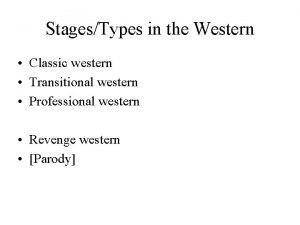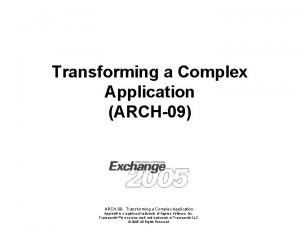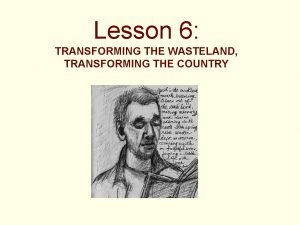The Church Transforming How the Western Church has





















- Slides: 21

The Church Transforming How the Western Church has responded to social change

What we covered last week ▪ The Church has steadily declined in numbers over the past 20 years. ▪ The Anglican Church has particularly felt this, losing 200, 000 people. ▪ If current trends continue, the last Anglican turns the lights out in roughly 2040. ▪ This decline is the result of dramatic cultural change. ▪ ‘God’ as society has understood that term, no longer has a place in collective thought and belief. ▪ We are challenged to proclaim the triune God in an areligious context

What we will explore today In this study, we will explore how churches have responded to the challenges we identified in the previous session. This will include: ▪ Different responses to the cultural shift. ▪ Exploring spiritualties and movements that have formed from it. ▪ Identifying the key philosophies that make these movements successful. ▪ Discussing how these philosophies fit with the call of the Church. ▪ Envisioning how we as a community might look if we engaged with them.

Opening Devotion “I appeal to you therefore, brothers and sisters, by the mercies of God, to present your bodies as a living sacrifice, holy and acceptable to God, which is your spiritual worship. Do not be conformed to this world, but be transformed by the renewing of your minds, so that you may discern what is the will of God – what is good and acceptable and perfect. ” Romans 12: 1 -2

How has the Church responded There are five broad categories into which the Church’s response can fit: 1. Reactionary Trying to put ‘Man come of age’ back in the playpen. 2. Accepting Embracing of change, seen as counter prophetic. 3. Delusionary Unable to accept that things have changed. 4. Confounded Loss of faith as ‘God’ loses ground to culture. 5. Proactive A mix of reaction and acceptance, change but challenge.

The movements of influence Societal Change Proactive • • • Embraces Challenges Personal Emotional Tangibility Reactionary Accepting Rejects Challenges Rationality Inerrancy Fundamentals • • • Accepts Encourages Reforming Developing Reimagining

The Reactionary Movement The reactionary movement has roots in enlightenment and modernist understandings of reason and culture. ▪ Strong emphasis on biblical education as counter to social narrative. Conservative theology. ▪ An underlying belief that reason precedes faith. We must come to truth before we can meet God. ▪ Truth and reason are defined by western, enlightenment thinking. To compete with science, bible must be historical and factual in modern sense of those words. ▪ Scripture must be inerrant, or there can be no truth and so no God.

The Accepting Movement The movement toward acceptance has its roots in a post-modern understanding of reason and society. ▪ Generally holds a progressive understanding of faith, that our understanding of God is progressing through the ages. ▪ Social change can be viewed as God’s prophetic witness to the Church to reimagine itself and its moral/theological grounds. ▪ A willingness to challenge traditional dogma and openness to other understandings of God and religious practice. ▪ Focus on developing communities that can access the divine in new ways.

The Proactive Movement The proactive movement holds the previous two in tension, but revisits Christian spirituality and practice to fit a new age. ▪ Understanding that story creates morality and belief, emphasis on Christian story as basis for practice, theology and morality. ▪ An inward turn spiritually, less focussed on communal and more on personal experience of God. ▪ Emphasis upon emotions as seat of faith. Assurance of salvation is tied to feeling of closeness to God. ▪ Emphasis on spiritual experience as means of making God real. The intangibility of faith becomes tangible in the Spirits descent.

How are they doing Each of these movements has a varying level of success. ▪ The reactionary movement is perhaps the strongest, particularly present in non-denominational churches. Offers certainty. ▪ The accepting movement is typically found in the mainline denominations and is the one that has seen greatest decline. ▪ The proactive movement is at work in both of the above and elsewhere. Particularly present in charismatic churches which see great growth. Makes the intangible for modern people. None of these movements is perfect – each reflects an element of faithful response as well as capitulation to an age, to a zeitgeist.

Which have you known in your time? Throughout our church experience we will likely have encountered each of these movements in some way. From an evangelist on a street corner to a priest offering direction, we will have seen them. As we break for a cup of tea or coffee, talk with others about: ▪ Where you have encountered these movements? ▪ What your reaction was/is to them? ▪ Do you feel you fit with any of them particularly? ▪ Which of the broader group of responses do you think our Parish embodies? (Reaction/Accepting/Delusion/Confounded/Proactive)

Which have you known in your time? What do you think are the strengths and weaknesses of the three movements we’ve discussed? ▪ Reactionary? ▪ Accepting? ▪ Proactive? Each of these movements finds a concrete reality in a church community or denomination. Where in Whangarei do you see examples of these movements?

Concrete forms of Reactionary Movement The reactionary movement finds its main inspiration from the American churches, particularly the Southern Baptist Movement. ▪ Sometimes known as fundamentalists ▪ Particularly successful examples of this movement are: – 7 th Day Adventist – Church of the Latter Day Saints (Mormons) – Jehovah’s Witnesses – Destiny Church

Concrete forms of Accepting Movement The accepting movement finds its base predominantly in the traditional western mainline churches, such as Anglicanism, Presbyterianism and Methodism. ▪ Sometimes known as liberal/progressive/”mainline”. ▪ Particularly successful examples of this movement are: – Presbyterian Community of St Luke, Remuera – Anglican Church of St Luke, Mt Albert – Co-operating Parish of Chartwell, Hamilton

Concrete forms of Proactive Movement The proactive movement is primarily found in churches we call charismatic, particularly those with large young adult congregations. ▪ This is a broad category and encompasses both denominational and non-denominational traditions. ▪ Particularly successful examples of this movement are: – Hillsong – Blueprint Church, Wellington – Anglican Church of St Paul, Symonds Street – Holy Trinity, Brompton (Home of Alpha Programme)

What is behind their success? For such a diverse group of churches to be ‘successful’ we have to concede that no one path is correct. ▪ What then sits behind the success of these concrete examples? ▪ Are there concepts that transcend the movements and their specific responses? Share your thoughts with those around you.

The heart of a living church In each of the examples we have discussed the clearly defined sense of mission transcends the differences of the movements and inspires their success. There is an innate sense within those attending these churches of who they are, what they are doing, why they are doing it and where they are going – as the people of God in that place. What do you believe the mission of the Anglican Parish of Whangarei to be?

A Missional Process Mission Purpose Intentionality Community

Isn’t it all about the worship? Each of the example churches we discussed worshipped in very different ways. But each way was appropriate to the context and mission of that church community. Worship is a reflection of a community common sense of purpose and mission. It is not the community’s mission! Worship is shaped by the intentionality of the community, which, in turn, is shaped by its sense of mission.

What does a missional church look like? All of the movements discussed produce missional churches. What would the Anglican Parish of Whangarei look like if it had a clear sense of mission? What, engaging with the missional process, would we need to do to get there?

What is the Church anyway? Next weeks session will broaden our horizon to the Church universal. ▪ What is the Church in scripture? ▪ How does Jesus’ kingdom of God connect with the New Testament Church? ▪ What is the relationship between God and the Church? ▪ What does all this mean for us?
 Sự nuôi và dạy con của hươu
Sự nuôi và dạy con của hươu điện thế nghỉ
điện thế nghỉ Các châu lục và đại dương trên thế giới
Các châu lục và đại dương trên thế giới Dot
Dot Thế nào là sự mỏi cơ
Thế nào là sự mỏi cơ Bổ thể
Bổ thể Phép trừ bù
Phép trừ bù Thiếu nhi thế giới liên hoan
Thiếu nhi thế giới liên hoan Chúa sống lại
Chúa sống lại Tia chieu sa te
Tia chieu sa te Một số thể thơ truyền thống
Một số thể thơ truyền thống Sơ đồ cơ thể người
Sơ đồ cơ thể người Tư thế ngồi viết
Tư thế ngồi viết Công của trọng lực
Công của trọng lực Số nguyên tố là
Số nguyên tố là đặc điểm cơ thể của người tối cổ
đặc điểm cơ thể của người tối cổ Tỉ lệ cơ thể trẻ em
Tỉ lệ cơ thể trẻ em Các châu lục và đại dương trên thế giới
Các châu lục và đại dương trên thế giới độ dài liên kết
độ dài liên kết ưu thế lai là gì
ưu thế lai là gì Thẻ vin
Thẻ vin Môn thể thao bắt đầu bằng từ đua
Môn thể thao bắt đầu bằng từ đua









































